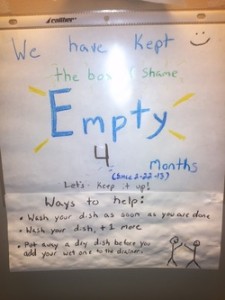 The graduate student lounge at the School of Information has a communal kitchenette which suffered from the common problems of shared kitchen spaces, not the least of which was a sink full of dirty dishes. Armed with the knowledge from my “Theories of Social Influence” class I set out to change the way my classmates behaved in a way that would make life better for all of us.
The graduate student lounge at the School of Information has a communal kitchenette which suffered from the common problems of shared kitchen spaces, not the least of which was a sink full of dirty dishes. Armed with the knowledge from my “Theories of Social Influence” class I set out to change the way my classmates behaved in a way that would make life better for all of us.
Problem: A shared sink full of dirty dishes
Previously, the dish problem was handled with the typical signs warning student’s that their mothers didn’t frequent our lounge or adorably warning them that there may be karmic consequences to leaving their dishes for someone else to clean up. This wasn’t particularly effective, and the sink usually contained several unwashed dishes.
Eventually, someone got fed up and decided it was time to take action. They created a ‘Box of Shame’ under the sink where they placed the unwashed dishes left in the sink, and posted a sign explaining the new ‘Box of Shame’ system. This made things worse.
The ‘Box of Shame’ system created a cultural norm which said it was ok to leave dishes in the sink (or directly in the box) instead of washing them. Instead of the ‘shame’ it’s creator hoped to impart, The box reinforced that other students were leaving their dishes, not just for an afternoon, but forever. The lounge quickly ran out of clean dishes as students adopted the new system and left their own dishes, or quickly move the dirty dishes of others out of the sink and out of sight.
Solution: Nudging the social norm towards dish washing
The first step was to post a sign above the dish rack calling attention away from the dirty dishes to the clean dishes others had washed in order to make people aware that others were following the broader cultural norm of washing their own dishes.
The next step was to empty the ‘Box of Shame’. I washed all the dishes that had collected in the box and for one month I diligently washed any dishes left in the sink. I noticed the volume of dirty dishes reduce drastically; as the box stayed empty, people were less likely to place a dirty dish in it.

The last step was to call attention to the new norm, and nudge people into complying with it. I did this by creating a new sign that replaced the ‘box of shame’ note.
The new sign has several features which encourage students to keep the sink clean.
- The message is framed in terms of the success of keeping the ‘box of shame’ empty, drawing attention to the positive behavior of dish washing, by not mentioning the behavior I was seeking to discourage.
- The sign features a smiling face because the feeling of being watched encourages users to comply with norms.
- The sign uses inclusive language, forcing the reader to think of themselves as a part of the ‘we’ that has kept the dishes clean.
- The sign contains a counter of the time the box has been empty, reinforcing with each month that others are adhering to the norm.
- The sign offers ways the reader can help the group achieve the goal, including suggesting behaviors which will compensate for those who break the norm (washing your dish, plus one more)
Result: A Clean Sink for nearly a year
For nearly a year, the dishes stayed washed. The “Box of Shame” stayed empty and people washed their own dishes, and any dishes that had been left. This system did eventually fail, and I have a theory about why, but I have graduated and so this is someone else’s challenge now.

